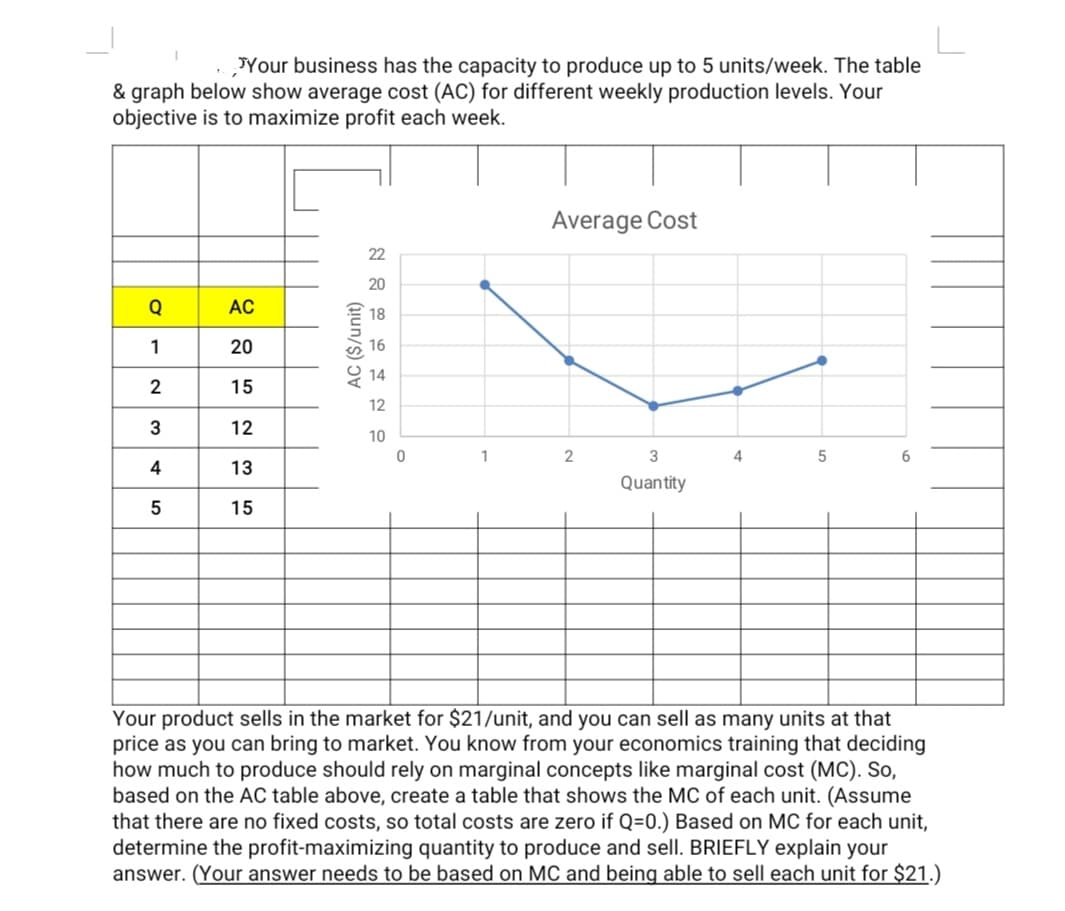JYour business has the capacity to produce up to 5 units/week. The table & graph below show average cost (AC) for different weekly production levels. Your objective is to maximize profit each week. Average Cost 22 20 Q AC 18 1 20 16 14 2 15 12 12 10 1 3 4 4 13 Quantity 15 Your product sells in the market for $21/unit, and you can sell as many units at that price as you can bring to market. You know from your economics training that deciding how much to produce should rely on marginal concepts like marginal cost (MC). So, based on the AC table above, create a table that shows the MC of each unit. (Assume that there are no fixed costs, so total costs are zero if Q=0.) Based on MC for each unit, determine the profit-maximizing quantity to produce and sell. BRIEFLY explain your answer. (Your answer needs to be based on MC and being able to sell each unit for $21.) 5, 2. AC ($/unit) 3.
JYour business has the capacity to produce up to 5 units/week. The table & graph below show average cost (AC) for different weekly production levels. Your objective is to maximize profit each week. Average Cost 22 20 Q AC 18 1 20 16 14 2 15 12 12 10 1 3 4 4 13 Quantity 15 Your product sells in the market for $21/unit, and you can sell as many units at that price as you can bring to market. You know from your economics training that deciding how much to produce should rely on marginal concepts like marginal cost (MC). So, based on the AC table above, create a table that shows the MC of each unit. (Assume that there are no fixed costs, so total costs are zero if Q=0.) Based on MC for each unit, determine the profit-maximizing quantity to produce and sell. BRIEFLY explain your answer. (Your answer needs to be based on MC and being able to sell each unit for $21.) 5, 2. AC ($/unit) 3.
Managerial Economics: A Problem Solving Approach
5th Edition
ISBN:9781337106665
Author:Luke M. Froeb, Brian T. McCann, Michael R. Ward, Mike Shor
Publisher:Luke M. Froeb, Brian T. McCann, Michael R. Ward, Mike Shor
Chapter7: Economies Of Scale And Scope
Section: Chapter Questions
Problem 7.5IP
Related questions
Question

Transcribed Image Text:JYour business has the capacity to produce up to 5 units/week. The table
& graph below show average cost (AC) for different weekly production levels. Your
objective is to maximize profit each week.
Average Cost
22
20
AC
18
1
20
14
2
15
12
3
12
10
1
2
4
4
13
Quantity
15
Your product sells in the market for $21/unit, and you can sell as many units at that
price as you can bring to market. You know from your economics training that deciding
how much to produce should rely on marginal concepts like marginal cost (MC). So,
based on the AC table above, create a table that shows the MC of each unit. (Assume
that there are no fixed costs, so total costs are zero if Q=0.) Based on MC for each unit,
determine the profit-maximizing quantity to produce and sell. BRIEFLY explain your
answer. (Your answer needs to be based on MC and being able to sell each unit for $21.)
AC ($/unit)
Expert Solution
This question has been solved!
Explore an expertly crafted, step-by-step solution for a thorough understanding of key concepts.
This is a popular solution!
Trending now
This is a popular solution!
Step by step
Solved in 2 steps with 1 images

Knowledge Booster
Learn more about
Need a deep-dive on the concept behind this application? Look no further. Learn more about this topic, economics and related others by exploring similar questions and additional content below.Recommended textbooks for you

Managerial Economics: A Problem Solving Approach
Economics
ISBN:
9781337106665
Author:
Luke M. Froeb, Brian T. McCann, Michael R. Ward, Mike Shor
Publisher:
Cengage Learning

Microeconomics: Private and Public Choice (MindTa…
Economics
ISBN:
9781305506893
Author:
James D. Gwartney, Richard L. Stroup, Russell S. Sobel, David A. Macpherson
Publisher:
Cengage Learning

Economics: Private and Public Choice (MindTap Cou…
Economics
ISBN:
9781305506725
Author:
James D. Gwartney, Richard L. Stroup, Russell S. Sobel, David A. Macpherson
Publisher:
Cengage Learning

Managerial Economics: A Problem Solving Approach
Economics
ISBN:
9781337106665
Author:
Luke M. Froeb, Brian T. McCann, Michael R. Ward, Mike Shor
Publisher:
Cengage Learning

Microeconomics: Private and Public Choice (MindTa…
Economics
ISBN:
9781305506893
Author:
James D. Gwartney, Richard L. Stroup, Russell S. Sobel, David A. Macpherson
Publisher:
Cengage Learning

Economics: Private and Public Choice (MindTap Cou…
Economics
ISBN:
9781305506725
Author:
James D. Gwartney, Richard L. Stroup, Russell S. Sobel, David A. Macpherson
Publisher:
Cengage Learning